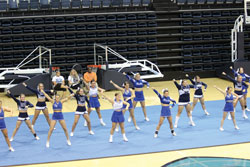The Outlook personnel have documented several places on campus this semester in which garbage and recycling receptacles have not been consistently available with one another. This occurrence has been spotted on the residential side of campus, as well as the area surrounding the Jules L. Plangere Center for Communication and McAllan Hall.
While pointing out that the University recycles 827 tons annually, Patti Swannack, Vice President of Administrative Services, ends the comment with a thought: “We believe we can improve that number.” However, one may find it challenging to improve that number when standing outside Plangere Center looking to recycle and there is no bin to do it.
John Morano, Environmental Author and Professor of Journalism said, “I first became aware of the problem when I arrived at campus and had a cup of coffee with me and I tried to throw out the cup and recycle the lid, which seems to be recyclable. When I came to the garbage pails at Plangere Center, there were only two garbage pails, side by side. And when I went to the next set of garbage pails, there were [also] only two side by side. So I had no option to recycle.”
Sierra Sorrentino, President of the Outdoors Club and senior Anthropology major said, “I’ve heard from a lot of people on campus that they’ve seen the recycling and trash being mixed together in the dumpsters by the custodians anyway, but I really hope that that’s just a rumor.”
While one may see campus custodial staff mix garbage and recycling in a seemingly careless manner, Fred Larson, custodian since 2008, says that the situation is more complicated than that. Larson explained, “When [students] come over and just drop a coffee [in the recycling] with all kinds of fluid in it, it’s damaged and the entire bin goes to the garbage. It’s tough.”
Dr. Thomas Herrington, Associate Director of Urban Coast Institute, said, “A recyclable that is thrown into a trash can is lost to the garbage stream and will be sent to a trash dump. Garbage that is thrown into a recyclable bin has much worse consequences as just one piece of garbage or even a dirty bottle, a piece of paper or cardboard (e.g., a pizza box) will contaminate all of the recyclable material in the bin or even a dumpster or truck.”
Although Swannack claimed that she was ordering additional receptacles for campus, when asked how many, where they might be located, and when they might be implemented, she could not provide any information. In her efforts to raise recycling awareness, Swannack said, “We plan to install posters in trash rooms and magnets on refrigerators in the Residence Halls to remind students of the correct way to recycle.”
Due to Monmouth’s location a mile from the beach, reducing the amount of plastics in the environment is particularly important because much of that material is likely to make its way into the ocean, according to Herrington. “Plastic material has been found in all parts of the ocean and even in its deepest depths,” he continued. “Marine organisms and birds ingest the plastics thinking they are food and worse, over time the plastics break down into microscopic particles that end up in the tissues of the fish we eat.”
Perhaps the recycling habits on campus would be easier to adhere to if receptacles were set up correctly, many are not. Morano said, “It makes me wonder how effective we are going to be if we are not offering people the option to recycle in certain areas.”
Erin Matyola, a junior in the Surf Club, said that lack of convenience is a deterrent in proper recycling habits for students. She said, “Sadly, many students are not willing to walk and find a recycling bin if it’s not convenient for them.”
Herrington believes, “To become greener, everyone should think about how they can eliminate single use material from their daily life. If it is impossible to eliminate a particular item, try to purchase items that can be reused like refillable water bottles. As a last resort, choose products that you can recycle. It is not always easy.”
The use of reusable products happens to be a common theme among students on campus. Sorrentino attests to this observation, “I see a lot of people using reusable water bottles on campus and that’s great, but I think both the University and the students should be more aware of the amount of waste they are making and try to reuse as much as possible.



